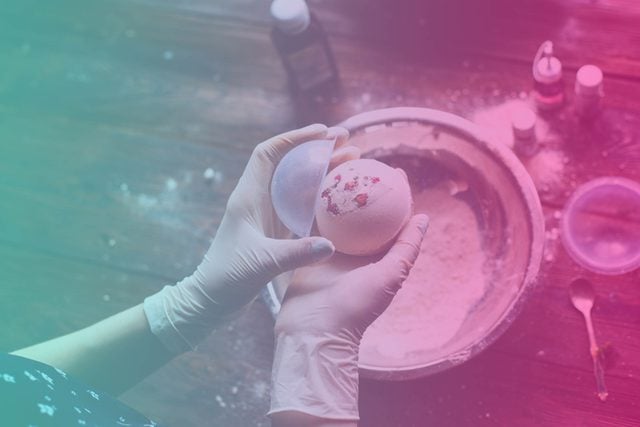This Is What’s Really In Your Bath Bomb
Updated: Dec. 21, 2022
The ingredients might surprise you.
It’s no mystery that bath bombs have been all the rage since they first emerged in 1989, and for good reason. They’re bubbly, vibrant, aromatic, sanitizing, and they spark an aesthetic cascade of sparkle that transports you to a dazzling (and Instagram-worthy) utopia. The bathroom experience is perhaps most enjoyed for its plethora of bath bombs—after all, what’s glamorous about bar soap? These circular explosive fizzies can seem like just the thing you need to make a washing experience something more than a mere obligation.
But aside from the captivating and magical allure of bath bombs, do you know what’s really inside that foamy substance you submerge your entire body into? While the experience of a bath bomb is well known to our generation, the technicalities of the stuff are not as readily recognized. We turned to two of the biggest bath bomb companies, LUSH and Pearl Bath Bombs, to find out.
Bath bombs were first invented in 1989, when product inventor and Lush co-founder Mo Constantine was inspired by the fast-fizzing action of the Alka Seltzer. She achieved that fizzy base renown throughout bathtubs worldwide with a simple combination of sodium bicarbonate (baking soda) and citric acid. In essence, bath bombs were comprised of a medley of natural ingredients that you can find in a typical household. In addition to this original foundation, a bespoke blend of ingredients were added to each bath bomb to produce an array of glamorous effects.
According to Meghan Campbell, LUSH Brand and Product Trainer, “All throughout our vast range of bath bombs, you’ll find ingredients like flower petals, vibrant pigments, plastic-free glitter, and the finest essential oils.”
On the other hand, Pearl Bath Bombs uses epsom salts and 100% pure sweet almond oil for added skin benefits.
Epsom salts are used to soothe sore muscles, while almond oil leaves your skin feeling soft, smooth, and hydrated. Instead of fragrance oil, we opted to use real, naturally derived essential oils such as lavender and lemongrass in some of our staple bath bomb scents for a more therapeutic bath experience,” says Tessa Medlock, Founder at Pearl Bath Bombs.
As the baking soda reacts with the citric acid, a reaction is ignited to produce that famous fizz and swirl when it comes in contact with water. To instigate that process, many places add FD&C dye and Sodium Lauryl Sulfoacetate (SLSA) to make the experience more colorful and foamy.

According to Tessa, “We chose to use SLSA in our bath bombs as a great alternative to SLS as it is 100% natural in origin, derived from coconut oils and meets ECOCERT natural and organic cosmetic standards.”
LUSH also makes a point to use only vegetarian food, drug, and cosmetics safe colors (FD&C) or drug and cosmetics safe colors (D&C) in their products, as well as natural color dyes like gardenia extract, which produces a vibrant orange/yellow hue.
“If we want our bath bombs to dissolve more slowly, we add our bubble bar mix to the outer layer, resulting in a frothy, foamy spectacle that spins across the surface of the water.” says Meghan.
As for the hot mess of sparkles that will linger in the tub after your bath bomb escapade, it isn’t your everyday glitter that you can pick up at a crafts store. According to Meghan, “At Lush we use non-plastic glitters in our products, and as a result, can speak to the benefits of keeping microplastics out of our waterways even when talking about shimmer!”
Instead, both LUSH and Pearl Bath Bombs use exclusively mineral based lustres, meaning they won’t leave a permanent glitter crime scene in your tub and can be washed down the drain safely without any detriment to waterways.
Surprisingly, the process of making a bath bomb is much more meticulous than you’d expect; each LUSH bath bomb is hand-pressed in their factories. Sodium bicarbonate is mixed with the color and fragrance custom to each bath bomb, and the resulting compound is mixed with citric acid and hand-packed into molds. This means there’s a constant assembly team of people, pressing hundreds of bath bombs per day.
If you have sensitive skin, not to fear. While bath bombs may throw off your vagina’s pH balance when applied too frequently, they can be used in conjunction with sensitive skin as long as you research their individual ingredients beforehand. For people whose skin is especially sensitive, bath bombs containing soothing essential oils (like lavender, chamomile, and rose) or shaved cocoa butter are the most suitable.
According to Meghan, “Bath bombs were actually invented with sensitive skin in mind. The inventor of the bath bomb has quite sensitive skin, and created the bath bomb to provide a fun, fresh alternative to your traditional liquid bubble baths, which mainly consist of synthetic lathering agents and perfumes that can irritate delicate skin.”
Pearl Bath Bombs also offer bath bombs that have no dye—“We also feature a completely unscented bath bomb with no dye, which lets our customers enjoy the same skin softening experience. Earlier this year we launched a line of luxe soaks, comprised of a variety of all natural salts and oils, perfect for someone with sensitive skin.”
In essence, these magical balls of fizz all come down to a very calculated scientific reaction that’s no different than dropping an Alka-Seltzer tablet in a glass of water. Their relatively simplistic formulas mean they are easy to make, and its sumptuous sensory experience may just be worth the hot pink bathtub ring that incurs in the process.
“The reason that we use color at all is to add to the effervescent, multi-sensory experience a bath bomb is intended to provide,” says Meghan. “Colors are capable of impacting our dispositions, in much the same way essential oils have been shown to have an effect on our moods, and for us the color and the spectacle is half the fun!”